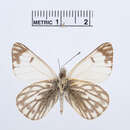Comprehensive Description
provided by Smithsonian Contributions to Zoology
Hypsochila penai Ureta
Hypsochila (Chionanema) peñai [sic] Ureta, 1955:67, 69, figs. 3, 4; 1956:161, pl. 1: figs. 3b, 3c.—Field, 1958:112 —Ureta, 1963:98.
Hypsochila (Chianomema [sic]) peñai [sic].—Peña, 1963:215.
Hypsochila (Chianonema [sic]) peñai.—Peña, 1974a:262 [required correction in spelling of specific name]; 1974b:39.
MALE (Figures 26, 38, photographs of a topotype).—Wings above and below white in ground color with dark markings as illustrated. This is the only species in the genus to have the ground color of hind wing and of the apex of the forewing white on the undersurface. It differs from H. wagenknechti wagenknechti in being much smaller and it is the same size as males of H. wagenknechti sulfurodice. The fuscous dark markings on both surfaces of apex of forewing cover a greater area than they do in the other species and are nearly confluent. The fuscous markings on the undersurface of hind wing are nearly black in color and are more extensive than in the other species of Hypsochila.
Length of forewing, 19–20 mm.
FEMALE (Figures 27, 39, figures of a topotype).—This sex differs from the females of the other species of Hypsochila in the same ways that the males do. It has all dark markings on the wings even more extensive and unlike the male it has the white ground color on both surfaces of wings faintly tinged with yellow.
Length of forewing, 20 mm.
VENATION (Figure 167).—Similar to that of H. argyrodice (Figure 162) in having vein M2 of the forewing arising from distinctly below apex of cell.
CLAW, PARONYCHIUM, AND PULVILLUS (Figure 186).—Claw with ventral tooth very small, smaller than in any of the other species, paronychium not distinctly different from the other species, pulvillus the smallest of any other species in the genus.
GENITALIA (Figure 131, male, drawn from preparation WDF 6578; Figure 149, female, drawn from preparation WDF 6651).—Similar to the other species in the genus.
TYPE DATA.—The type-locality is given in the original description as “Laguna Verde, 5200 m., Cordillera de Antofagasta,” = east of Volcán Hékar, Province of Antofagasta, Chile. This is not the Laguna Verde in the southwest corner of Bolivia. Luis E. Peña on a map sent to the senior author of the present paper shows this type-locality to be not far from the Salar de Atacama. This species was described from the holotype and one paratype, both males collected by Luis E. Peña at 5200 meters, 13 December 1953 (holotype) and at 5000 meters, 14 December 1953 (paratype). The holotype is in the collection of the National Museum of Natural History, Santiago, Chile, and the paratype is in the collection of Luis E. Peña. The female was later described by Peña (1974b:39) from the same locality.
ETYMOLOGY.—The name penai is a masculine noun in the genitive case, a patronym after Luis E. Peña, the collector of the original series and the preeminent and indefatigable collector of the fauna of the Andes.
NATURAL HISTORY.—Ureta (1955:69) reports that Peña has observed that this species (observations on the male sex), when resting on the ground, folds all four wings together and inclines them to one side close to the ground. This perhaps affords the least possible resistance to the strong winds that are common where these butterflies are found. Also perhaps by exposing their undersurfaces with their dark vein pattern they may absorb heat from the sun. The butterflies fly very rapidly and compete admirably against the strong prevailing winds. They visit the flowers of Perezia atacamensis (Philippi) and this plant may be the food plant of the larvae (Peña, 1963:215).
DISTRIBUTION (see Map 1).—This species flies at the highest elevations of any species of Hypsochila, occurring between 4500 and 5200 meters elevation. As far as is known at present H. penai and H. wagenknechti do not overlap in horizontal distribution and it is certain that they do not overlap in altitudinal distribution.
MATERIAL EXAMINED.—We had for study three males (4 January 1958; November 1961) and one female (20 January 1974), all topotypes.
Phulia Herrich-Schäffer, 1867:101, 104–105, 144.—Butler, 1870:38, 52.—Kirby. 1871:505.—Scudder, 1875:249.—Reed, 1877:655, 656–657.—Slaudinger, 1885:46.—Shatz and Röber, 1886:55.—Garlepp, 1892:273, 274, 275.—Dixey, 1894:307, 323, 324, 325.—Staudinger, 1894:43–46.—Elwes, 1895:lxv–lxvi.—Bartlett-Calvert, 1898:98.—Grote, 1900:19, 20, 22.—Röber, 1909a:97–98, pl. 28,—Dixey, 1910:xciv, xcix, cxxxiv.—Röber, 1910:97–98, pl. 28.—Giacomelli, 1915:404; 1916:43.—Jörgensen, 1916:428, 432, 434, 515–517.—Giacomelli, 1917:384, 385.—Röber, 1924a:1024, pl. 192; 1924b: 1024, pl. 192.—Köhler. 1928:1.—Talbot, 1932:59–60.—Klots, 1933:154. 158. 219–220. 230, 238, pl. 12: fig. 89.—Talbot, 1935:627.—Ureta, 1938a:283–287; 1938b: 124,—Breyer, 1939: 46–47.—d'Almeida, 1943:97.—Ureta, 1947:50–52.—Hayward, 1951:95.—Zischka, 1951:29–30.—Herrera, 1954b:52.—Ureta, 1955:57, 69.—Herrera and Etcheverry, 1956:284.—Ehrlich, 1958:325.—Field, 1958:103, 104, 105, 112–114, figs. 4, 12, 20, 28, 37.—Forster, 1958:845–846.—Hughes, 1958:7–8.—Ureta. 1963:98–99.—Hemming, 1967:361.
Phulia (Phulia).—Field, 1958:104, 105, 106, 114, figs. 4, 12, 20, 28, 37.
TYPE-SPECIES.—Pieris nymphula Blanchard = Phulia nymphula (Blanchard). Type by reason of being the sole included species
- bibliographic citation
- Field, William Dewitt and Herrera, José. 1977. "The Pierid butterflies of the genera Hypsochila Ureta, Phulia Herrich-Schäffer, Infraphulia Field, Pierphulia Field, and Piercolias Staudinger." Smithsonian Contributions to Zoology. 1-64. https://doi.org/10.5479/si.00810282.232

